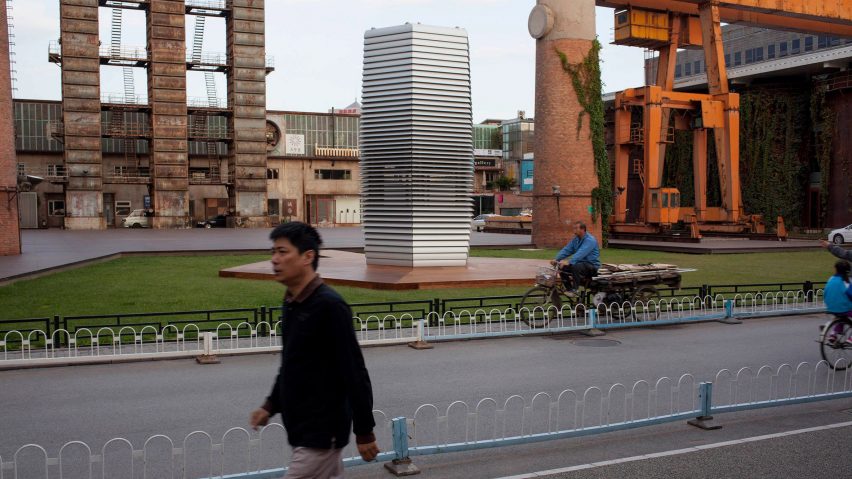Pollution poses a serious threat to the world's land, air and oceans, so one of our Good Design for a Bad World talks will look at ways of reducing the scale of the problem. Here are eight proposals that are already exploring the idea.
Good Design for a Bad World takes place during Dutch Design Week, on 21 and 22 October 2017. Five talks scheduled across the weekend will look at ways designers can tackle five global issues: climate change, pollution, refugees, terrorism and politics.
Moderated by Dezeen founder and Dutch Design Week international ambassador Marcus Fairs, the pollution talk will feature a panel of speakers including industrial designer Dave Hakkens, This is Ecocide founder Bernhard Lenger, and DoepelStrijkers co-founder Eline Strijkers.
The event is free to attend, and it takes place at the People's Pavilion at KetelHuisplein 1, in the Strijp-S district of Eindhoven, at 12:30pm on Sunday 22 October.
Ahead of the talk, here's eight responses to pollution from architects and designers all around the world, including a tower that could rid cities of smog and swimming costumes made from plastic.
Smog Free Tower by Daan Roosegaarde
Daan Roosegaarde describes his Smog Free Tower as the largest air purifier in the world. It works by sucking polluted air in through its top, and then releasing purified air through vents on its four sides.
Last year, the Chinese government publicly confirmed its support for the Smog Free Project, so Roosegaarde is currently engaging with government officials and local designers to scale it up, to rid the whole of Beijing of pollution.
Find out more about Smog Free Tower ›
This one-piece suit has electrical threads woven into the fabric, enabling it to provide GPS, Wi-Fi and – most relevantly – air-cleaning technologies.
It is fitted with an air quality sensor on its chest, which is connected to a hidden chip that tracks and transmits the data. The chip is also wired to a battery and the cold plasma node on the back of the suit, which is used to create a "clean air bubble" around the wearer.
"Cold plasma technology is a really high voltage that splits up the particles in the air," said the designers. "It grabs the dust and then it drops, so all the bad particles in the air go down to the ground."
Find out more about BB.Suit 0.2 ›
East Coast Park beach huts by Spark
It is not just the problem of air pollution designers are looking to solve. Many are turning their attention to the abundance of waste in the oceans, including architecture studio Spark, which envisioned using some of the millions of tons of plastic dumped into the sea every year to build a series of unusual architectural structures along Singapore coastline.
The team proposed collecting this material, sorting it into colours, then shredding it. The granules would then be poured into shingle-shaped moulds and reheated, creating a new type of tile for cladding a building's exterior.
Find out more about East Coast Park beach huts ›
Ocean plastic swimwear by Adidas x Parley
This collaborative project between sports brand Adidas and environmental initiative Parley has been a pioneer in repurposing ocean plastic, creating shoes and swimwear from upcycled fishing nets and debris.
In an interview with Dezeen, Parley founder Cyrill Gutsch said designers and brands need to wean themselves off the plastic "drug".
Find out more about ocean plastic swimwear ›
Flat-packed furniture by Pentatonic
Aiming to "radically transform consumption culture", start-up company Pentatonic is working with an adapted injection-moulding process to transform waste materials – such as cigarette butts, smartphones and cans – into homeware.
The company also operates a "circular economy" system. Customers can sell back pieces of their furniture to Pentatonic, so that they can be recycled and reintroduced into the supply chain.
Find out more about flat packed furniture ›
Dutch engineering student Boyan Slat created The Ocean Cleanup concept with the aim of clearing the oceans of their plastic, using a floating barrier that slowly pushes the plastic to shore. Once ashore, the waste plastic could be recycled and turned into sellable products to help fund the project.
Earlier this year, Slat announced that the company's first major operation will begin in 2018 in an area known as the Great Pacific Garbage Patch – a swirling vortex of mainly plastic waste located in the northern part of the Pacific Ocean.
Find out more about The Ocean Cleanup ›
The Cape by Clare Cousins and The Sociable Weaver
This timber-clad residence designed by Australian firms Clare Cousins Architects and The Sociable Weaver was the first home in the Australian state of Victoria to achieve a "10 Star" energy rating.
During the build, the architects worked with suppliers to reduce packaging that was delivered to site, and recycled and repurposed as much material as possible – meaning just three rubbish bags of waste were sent to landfill during the entire construction period.
Find out more about The Cape ›
AMP Spacecraft by DK Osseo-Asare and Yasmine Abbas
Agbogbloshie, Ghana, is the world's largest dumping site for electronic waste. But architects DK Osseo-Asare and Yasmine Abbas are developing a functioning infrastructure to transform this toxic place into a more habitable environment for the thousands of people that already live there.
Named AMP Spacecraft, the initiative involves a network of "makerspace" structures, which arw hubs where local scrap dealers and makers can go about their trade and learn new skills. The architects call each one an "open community workshop cum lab" dedicated to recycling, making, sharing and trading.
Find out more about AMP Spacecraft ›

